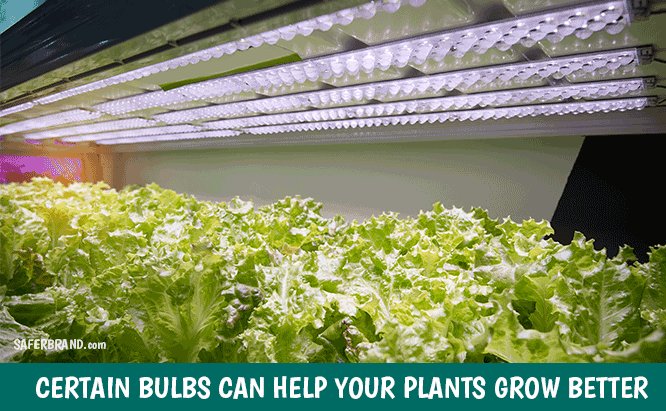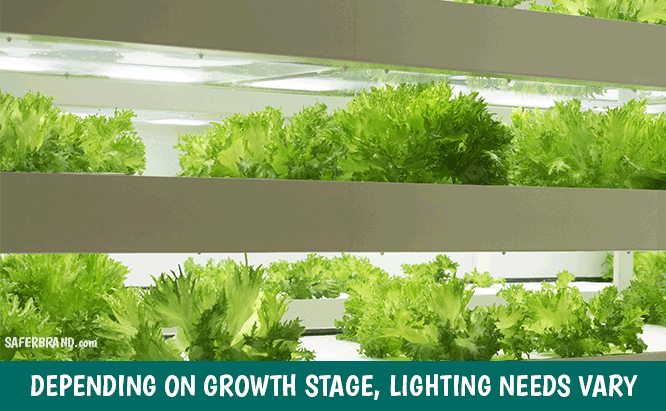
When you set up a hydroponic garden (or even an indoor garden), a light system is usually part of the plan. Only on occasion do you set up an indoor garden and then allow the natural sunrise-sunset cycle meet its sunlight requirements. This is because, to get reliable growth, your plants would need to be placed in a south- or west-facing window to receive the sunlight plants need.
Instead of relying on windows and the natural sun, your best bet is to set up a light rack, which allows your garden to grow anywhere. With a light rack, you can grow in a spare bedroom, the garage, on the kitchen table or even in an unused closet.
Your light system has its own needs, of course. You will have to buy special bulbs and set that system on a timer. But what are the actual requirements for this replacement sun? How much “sun” should your plants get each day?
Indoors vs. Outdoors?
Choosing to plant your garden indoors versus outdoors comes with its own set of challenges. Indoor gardens, whether they’re hydroponic or soil-based, need light to fuel the process of photosynthesis, which creates the energy a plant needs to grow. Additionally, your garden will require you to supply it with nutrients, water and a growing medium.
Those requirements may seem intimidating, but there are also plenty of benefits to an indoor or hydroponic garden.
- You can grow (and harvest) your crop year round.
- Pests are unlikely, and they can be quickly controlled.
- Plant diseases and fungi are less likely.
- Few to no weeds can find their way inside.
- After setup, indoor gardens often require less maintenance.

Getting the Right Bulbs
There are a lot of different bulbs available for your indoor or hydroponic garden. Each bulb style may have a number of different ratings that dictate its usability in your garden. Among them are measurements in lumens, lux, kelvin and PAR.
What’s best for your plant? Well, it all depends on the needs of your crop and, at any given time, which growth stage your plant is at. With all those factors in play, its best to consult individual growing instructions for your plant and its variety. Chances are you will have to swap bulbs throughout the growing process.
You’ll also want to consider the amount of electricity it uses, since that can greatly affect the total cost of growing at home.
Why Not Use Lights 24-7?
It would seem that simply leaving the lights on 24-7 would be the best way to trigger massive growth and produce a record yield. Unfortunately, that idea has been tested and many plants simply do not produce well when subjected to unrelenting light.
In fact, plants exposed to nonstop sunlight through their lifetime typically produce a smaller yield than plants that get a daily break from light.
What about plants in the Arctic Circle? They see 24-hour sun exposure for several weeks and grow huge. The answer is simple: These plants are often genetcally adapted, selectively bred and provided helpful nutrients to balloon to these massive sizes. Further, they respond to environmental cues to grow fast and grow strong before the growing season ends.
Following those ideals, you could grow some monster-sized plants under a 24-7 lighting situation, but it may take a lot of trial and error before you hit on a high-producing strain.

What Do Plants Do at Night?
At night, plants cease performing photosynthesis, the process that converts sunlight, CO2 and other nutrients into a store of energy in the form of starch.
While photosynthesis stops, plants turn their focus to respiration. In the day time, respiration involves drawing in CO2, oxygen, water and other nutrients to supply plant cells with sustenance. At night, the process continues but without the drag of having to immediately use up all those nutrients. Basically, the lack of light allows the plant to reset itself and move those nutrients to where they’ll be used when sunlight arrives the next day.
In other words, without a break in sunlight, a plant has a hard time “catching its breath” so that it can properly refuel and redistribute its water and other nutrients. Yes, plants do continue to grow at night, they just aren’t creating fuel via photosynthesis at the same time.
Lights On, Lights Off: How Much Light Do Plants Need?
Through trial and error, gardeners have found the peak light-dark cycle varies according to a crop’s stage of development. It also varies according to the type of plant. Tomato seedlings, for example, appear to do incredibly well on an 18-12 cycle. Yes, that means eighteen hours of light followed by 12 hours of darkness.
“Wait a second,” we can hear you say, “Eighteen plus 12 doesn’t equal 24!”
That’s right, it doesn’t, but since you’re running the show and not Mother Nature, you can set you lights on a timer so they do operate on an 18-12 cycle. Yes, such a cycle will mean your seedlings’ “day” will bleed into the night, then flip-flop entirely and maybe even go back again, but you’ll get robust growth as a result.
This 18-12 cycle is only temporary, though, and is only for use early on in your growing season. It should eventually bleed into a 16-8 cycle followed by a 12-12 cycle just before harvest.
Why can’t the light-dark cycle stay at 18-12 (or 16-8) forever? Just as sunlight durations change in the real world, they also need to change for your indoor crop. In fact, your plants need these indicators to trigger their blooming and fruiting stages.
Because of these light requirements, it’s important to recognize your crop’s stage of development and provide for its needs along the way since different plant growth stages have different nutritional requirements.

Light Movers
To make your light system even more effective, you can attach them to a light mover. This device moves your lights across your grow room to simulate the path of the sun. This allows leaves that are shadowed by other foliage to still get the light they need by distributing the light more evenly. The goal of the light mover is to move the light slowly across the room, otherwise, gardeners would simply push the lights to a new spot every few hours.
More Help for Your Indoor Hydroponic Garden
If you’re looking for more ideas and advice on setting up and operating your hydroponic garden, then check out the Safer® Brand community on Facebook. We offer hydro-friendly advice and OMRI Listed® pest control options along with our line of liquid and granular nutrients. To get a special announcements from Safer® Brand, subscribe to our E-Newsletter, which also offers links to helpful gardening, lawn and household articles.
To help you save on your purchases, join our Rewards Points program, which gives you money back for future orders.



